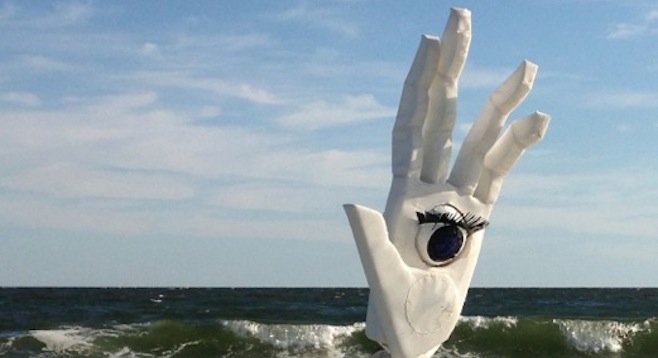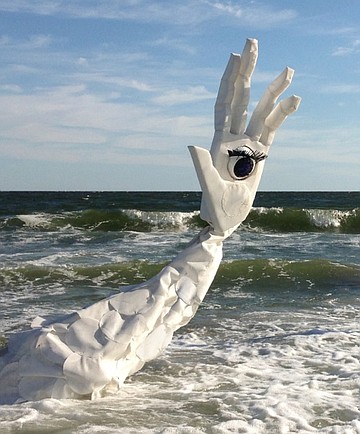 Facebook
Facebook
 X
X
 Instagram
Instagram
 TikTok
TikTok
 Youtube
Youtube

The Scripps Institute of Oceanography has catalogued countless species of marine life. But they have never - and will never again after this coming Sunday - witnessed who emerges from the whitewater at La Jolla Shores Beach.
As Ymiko Tanaka’s music blares (when you go, steer clear of the speakers concealed in beige camouflage netting), Basil Twist, world famous puppeteer, recreates Sandro Botticelli’s 1486 painting “The Birth of Venus.”
Okay, not the whole painting, where she barely covers her nudity while surfing to shore on a large half-shell. It’s a PG Venus, but she’s HUGE: her head’s 12, maybe 15 feet tall; her long blond hair recalls the original (and its model, Simonetta Cattaneo Vespuchi, who has rivaled the Mona Lisa for centuries, and not for her smile); her long eyelashes are dark blue, her lips an almost mute pink.

And there she is: suddenly. In many ways, though the performance lasts 30 minutes, Seafoam Sleepwalk happens in a single, unforgettable moment. That head rises, dripping with foam, and rises, and – OMG – rises!
And it then moves from side to side, rocking in counterpoint to the waves trundling shoreward.
There’s a kind of story. Golden golden-winged cherubs salute her arrival. And there’s a transformation in the end, accompanied by imitation Jaws-music, that’s open to interpretation.
Part of the site-specific fun of the piece: life goes on around it. Surfers wipe out in the distance, people stroll the beach (which, even when crowded, is one of the most peaceful places in San Diego), and construction never ceases on homes craning for a better view of the ocean.
Seafoam Sleepwalk. La Jolla Shores Beach, about a block and a half south of Scripps Pier. Playing through Sunday, October 6 at 1:00 p.m. and 3:00 p.m. Admission is free.
The real star of Thomas Pynchon’s latest work, Bleeding Edge, is New York City. He draws it so well the book qualifies as a site-specific novel.
The real star of Hedda-ing – choreographed and directed by Sam Mitchell – is the Fallen Star Sculpture at UCSD. Do Ho Suh’s creation is a one-room, baby blue house tilted to one side. The angle’s so much like Dorothy’s in the Wizard of Oz you half expect ruby red slippers poking out below.
But there’s a difference. The house is on the seventh floor of the Jacobs School of Engineering, on the roof, and almost two-thirds of it hangs over the edge. In thin freaking air!
And, of course, half the performance takes place inside the house, askew. To keep balance, everyone must lean to the south, and pray no gust of serious wind blows through.
Except for some Norwegian words, which probably come from Ibsen’s Hedda Gabler, the presentation is non-verbal – and strange.
A brief description says the piece is about “the polarities that exist between the role of a home as a sanctuary and as a prison.”
That makes sense, since two women, dressed in mourning, begin inside, and two men outside. And each relates to his/her surroundings with either safety or claustrophobia.
Many site specific works are open-ended. They may have distinct meanings for the creators, but are free-form for spectators. You can participate not only in the show, but also in what it means to you.
My take on Hedda-ing (which may have nothing to do with the author’s intent). The gerund, –ing, suggests an ongoing action. When the audience arrives, the performers tremble and shudder and shake themselves back to life. They even acknowledge our presence.
Then they perform a scene from Hedda Gabler: Hedda’s indifferent husband, George Tesman, is in the garden, in a wheelchair, as is Eilert Lovborg, the un-recovering alcoholic eager to publish a manuscript.
Inside are Thea Elvsted, nervous, unhappily married with an eye on Lovborg; and Hedda, the legendary “eagle in a cage,” jealous of Thea, furious at her husband’s passivity, and locked in a society so rigid her life is on tilt.
Every time an audience arrives, the four performers must re-enact – must –ing Hedda again. They shudder to life, then shudder back down, like rag dolls, when the story’s told.
Hedda-ing. Fallen Star Sculpture, Jacobs School of Engineering (due east, and uphill from the central library), playing through Sunday, October 6; every half-hour from 2:30 p.m. to 4:00 p.m.


The Scripps Institute of Oceanography has catalogued countless species of marine life. But they have never - and will never again after this coming Sunday - witnessed who emerges from the whitewater at La Jolla Shores Beach.
As Ymiko Tanaka’s music blares (when you go, steer clear of the speakers concealed in beige camouflage netting), Basil Twist, world famous puppeteer, recreates Sandro Botticelli’s 1486 painting “The Birth of Venus.”
Okay, not the whole painting, where she barely covers her nudity while surfing to shore on a large half-shell. It’s a PG Venus, but she’s HUGE: her head’s 12, maybe 15 feet tall; her long blond hair recalls the original (and its model, Simonetta Cattaneo Vespuchi, who has rivaled the Mona Lisa for centuries, and not for her smile); her long eyelashes are dark blue, her lips an almost mute pink.

And there she is: suddenly. In many ways, though the performance lasts 30 minutes, Seafoam Sleepwalk happens in a single, unforgettable moment. That head rises, dripping with foam, and rises, and – OMG – rises!
And it then moves from side to side, rocking in counterpoint to the waves trundling shoreward.
There’s a kind of story. Golden golden-winged cherubs salute her arrival. And there’s a transformation in the end, accompanied by imitation Jaws-music, that’s open to interpretation.
Part of the site-specific fun of the piece: life goes on around it. Surfers wipe out in the distance, people stroll the beach (which, even when crowded, is one of the most peaceful places in San Diego), and construction never ceases on homes craning for a better view of the ocean.
Seafoam Sleepwalk. La Jolla Shores Beach, about a block and a half south of Scripps Pier. Playing through Sunday, October 6 at 1:00 p.m. and 3:00 p.m. Admission is free.
The real star of Thomas Pynchon’s latest work, Bleeding Edge, is New York City. He draws it so well the book qualifies as a site-specific novel.
The real star of Hedda-ing – choreographed and directed by Sam Mitchell – is the Fallen Star Sculpture at UCSD. Do Ho Suh’s creation is a one-room, baby blue house tilted to one side. The angle’s so much like Dorothy’s in the Wizard of Oz you half expect ruby red slippers poking out below.
But there’s a difference. The house is on the seventh floor of the Jacobs School of Engineering, on the roof, and almost two-thirds of it hangs over the edge. In thin freaking air!
And, of course, half the performance takes place inside the house, askew. To keep balance, everyone must lean to the south, and pray no gust of serious wind blows through.
Except for some Norwegian words, which probably come from Ibsen’s Hedda Gabler, the presentation is non-verbal – and strange.
A brief description says the piece is about “the polarities that exist between the role of a home as a sanctuary and as a prison.”
That makes sense, since two women, dressed in mourning, begin inside, and two men outside. And each relates to his/her surroundings with either safety or claustrophobia.
Many site specific works are open-ended. They may have distinct meanings for the creators, but are free-form for spectators. You can participate not only in the show, but also in what it means to you.
My take on Hedda-ing (which may have nothing to do with the author’s intent). The gerund, –ing, suggests an ongoing action. When the audience arrives, the performers tremble and shudder and shake themselves back to life. They even acknowledge our presence.
Then they perform a scene from Hedda Gabler: Hedda’s indifferent husband, George Tesman, is in the garden, in a wheelchair, as is Eilert Lovborg, the un-recovering alcoholic eager to publish a manuscript.
Inside are Thea Elvsted, nervous, unhappily married with an eye on Lovborg; and Hedda, the legendary “eagle in a cage,” jealous of Thea, furious at her husband’s passivity, and locked in a society so rigid her life is on tilt.
Every time an audience arrives, the four performers must re-enact – must –ing Hedda again. They shudder to life, then shudder back down, like rag dolls, when the story’s told.
Hedda-ing. Fallen Star Sculpture, Jacobs School of Engineering (due east, and uphill from the central library), playing through Sunday, October 6; every half-hour from 2:30 p.m. to 4:00 p.m.
Comments